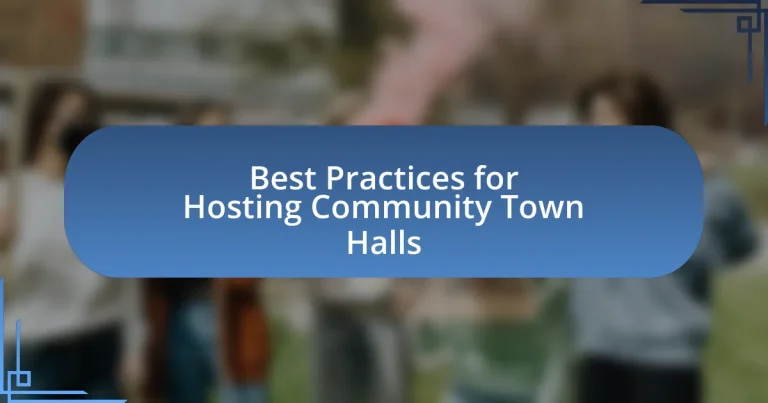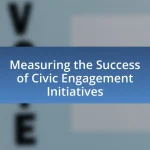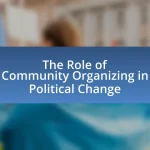The article focuses on best practices for hosting community town halls, emphasizing the importance of clear communication, effective planning, and active engagement. It outlines key elements for successful town halls, including structured agendas, accessible venues, and the use of technology to enhance participation. The article also discusses the significance of community town halls in fostering transparency and trust between local officials and residents, as well as strategies to maximize participation through targeted outreach and incentives. Additionally, it highlights the importance of follow-up actions and effective communication of outcomes to strengthen community ties and improve future events.
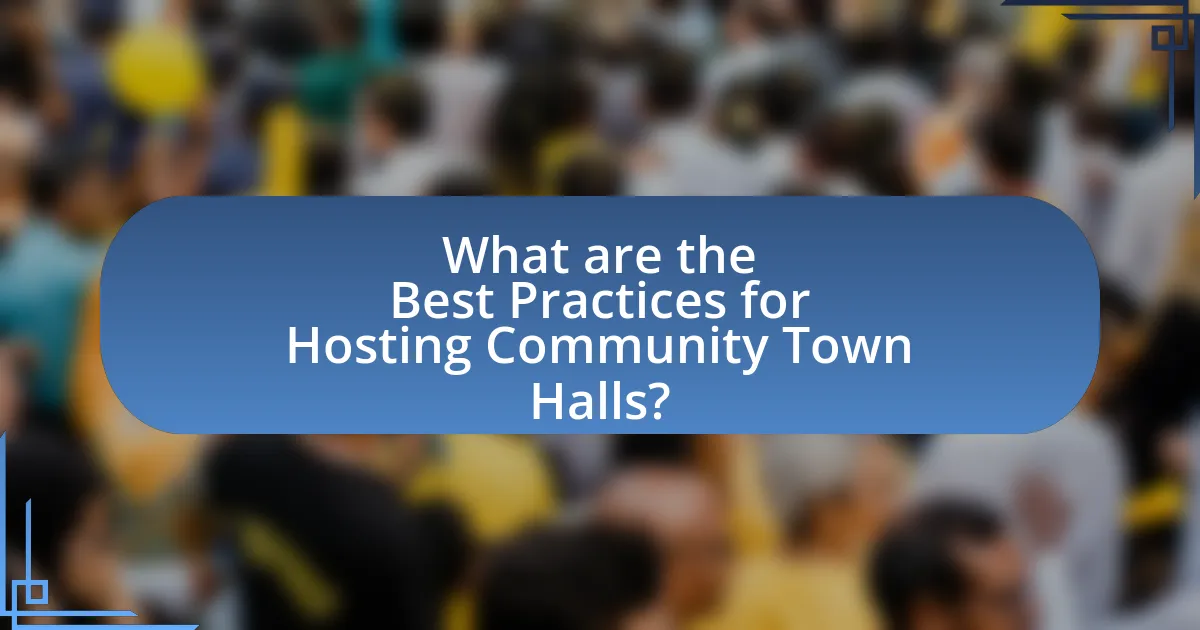
What are the Best Practices for Hosting Community Town Halls?
The best practices for hosting community town halls include clear communication, effective planning, and active engagement. Clear communication ensures that all participants understand the purpose and agenda of the town hall, which can be achieved by distributing information in advance through various channels such as emails, social media, and community boards. Effective planning involves selecting an accessible venue, setting a convenient date and time, and preparing necessary materials, which can enhance participation and organization. Active engagement can be fostered by encouraging questions and feedback during the event, utilizing interactive tools like polls or Q&A sessions, and ensuring that all voices are heard, which has been shown to increase community trust and involvement. These practices are supported by research indicating that well-structured town halls lead to higher satisfaction and participation rates among community members.
Why are Community Town Halls Important?
Community Town Halls are important because they facilitate direct communication between local government officials and residents, fostering transparency and civic engagement. These gatherings allow community members to voice their concerns, ask questions, and provide feedback on local issues, which can lead to more informed decision-making by officials. Research indicates that communities with active town hall meetings report higher levels of trust in local government and increased participation in civic activities, demonstrating their effectiveness in strengthening community ties and promoting democratic processes.
What role do they play in community engagement?
Community town halls play a crucial role in community engagement by facilitating direct communication between local leaders and residents. These events provide a platform for citizens to voice their concerns, share ideas, and participate in decision-making processes. Research indicates that town halls enhance civic participation, as evidenced by a study from the National Civic League, which found that communities with regular town hall meetings experience increased voter turnout and stronger community ties. This direct interaction fosters transparency and accountability, ultimately leading to more informed and engaged citizens.
How do they foster transparency and trust?
They foster transparency and trust by openly sharing information and encouraging community participation. This approach includes providing clear agendas before town hall meetings, allowing community members to voice their concerns and questions, and ensuring that responses are honest and comprehensive. Research indicates that communities with transparent communication practices experience higher levels of trust; for example, a study by the International City/County Management Association found that 75% of residents felt more engaged when local governments practiced transparency.
What are the key elements of a successful Town Hall?
The key elements of a successful Town Hall include clear communication, community engagement, and effective facilitation. Clear communication ensures that the purpose and agenda of the Town Hall are well-defined and shared with participants in advance, which fosters transparency and sets expectations. Community engagement involves actively encouraging participation from attendees, allowing them to voice their concerns and suggestions, which enhances the sense of ownership and connection to local issues. Effective facilitation is crucial for managing discussions, keeping the meeting on track, and ensuring that all voices are heard, which can be supported by trained moderators or facilitators. These elements collectively contribute to a productive and inclusive Town Hall experience.
How should the agenda be structured?
The agenda should be structured with clear time allocations for each topic, ensuring a logical flow from introductions to discussions and conclusions. This structure typically includes an opening statement, followed by key topics such as community updates, open forum discussions, and closing remarks. Each section should have designated time limits to maintain focus and engagement, allowing participants to prepare for their contributions. Research indicates that well-structured agendas enhance participation and satisfaction, as seen in a study by the International Association for Public Participation, which found that organized meetings lead to more effective community engagement.
What is the ideal location for hosting a Town Hall?
The ideal location for hosting a Town Hall is a central, accessible venue that accommodates the expected audience size. Locations such as community centers, local schools, or municipal buildings are often preferred because they are familiar to residents and typically equipped with necessary facilities. Research indicates that accessibility, including public transportation options and parking availability, significantly influences community participation in such events. For example, a study by the International City/County Management Association found that Town Halls held in easily reachable locations saw a 30% increase in attendance compared to those in less accessible areas.
How can technology enhance the Town Hall experience?
Technology can enhance the Town Hall experience by facilitating real-time communication and engagement between community members and local officials. Tools such as live streaming and video conferencing allow individuals who cannot attend in person to participate actively, increasing overall attendance and involvement. For instance, a study by the International City/County Management Association found that municipalities using digital platforms for Town Halls saw a 30% increase in public participation. Additionally, interactive polling and Q&A features enable immediate feedback and address community concerns effectively, fostering a more inclusive environment.
What tools can be used for virtual Town Halls?
Virtual Town Halls can be effectively conducted using tools such as Zoom, Microsoft Teams, and Webex. These platforms provide features like video conferencing, screen sharing, and chat functionalities, which facilitate real-time interaction and engagement among participants. For instance, Zoom supports up to 1,000 video participants and offers breakout rooms for smaller discussions, making it suitable for large community gatherings. Microsoft Teams integrates with other Microsoft Office applications, enhancing collaboration and document sharing during the event. Webex is known for its robust security features, ensuring a safe environment for discussions. These tools are widely adopted for their reliability and user-friendly interfaces, making them ideal for hosting virtual Town Halls.
How can social media be leveraged for engagement?
Social media can be leveraged for engagement by facilitating real-time interaction and feedback between community members and organizers. Platforms like Facebook, Twitter, and Instagram allow for live Q&A sessions, polls, and discussions that encourage participation and foster a sense of community. According to a study by the Pew Research Center, 69% of adults in the U.S. use social media, making it a powerful tool for reaching a broad audience and enhancing engagement during community town halls.
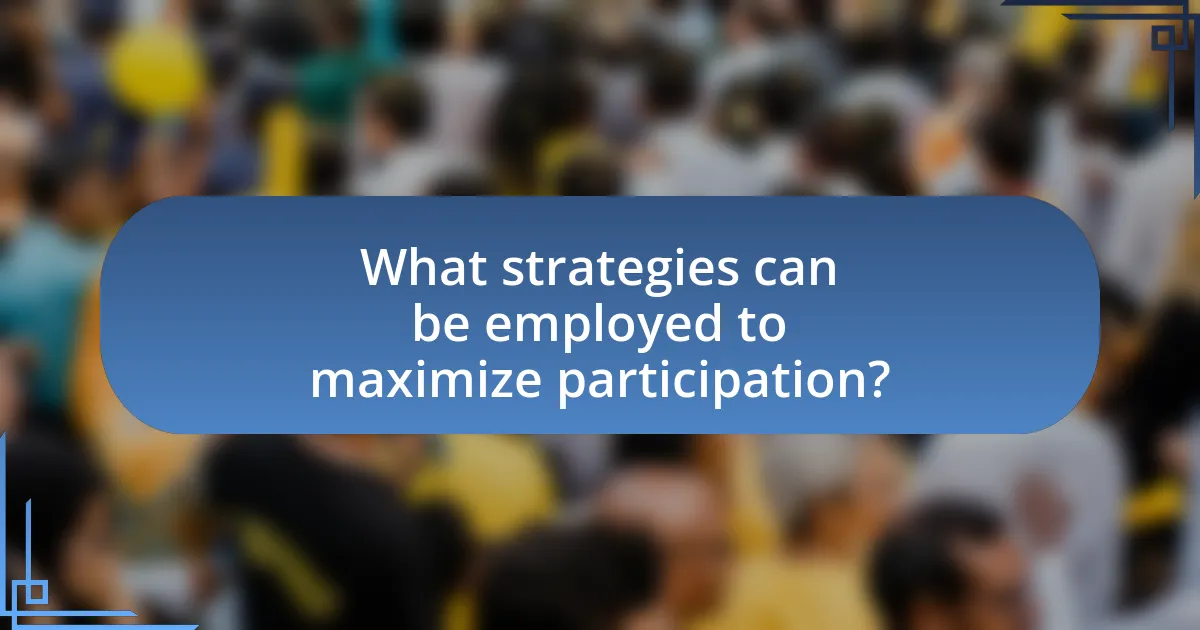
What strategies can be employed to maximize participation?
To maximize participation in community town halls, employing strategies such as targeted outreach, engaging formats, and accessibility enhancements is essential. Targeted outreach involves identifying and reaching out to specific community groups through tailored communication channels, which can increase awareness and interest. Engaging formats, such as interactive discussions or workshops, encourage active involvement and make participants feel valued. Accessibility enhancements, including providing translation services and ensuring venues are physically accessible, remove barriers that might prevent attendance. Research indicates that communities that implement these strategies see a significant increase in participation rates, as evidenced by a study from the International Association for Public Participation, which found that targeted outreach can boost attendance by up to 50%.
How can outreach be effectively conducted?
Effective outreach can be conducted by utilizing targeted communication strategies that engage the community. This involves identifying key stakeholders, leveraging social media platforms, and organizing informational sessions to foster dialogue. Research indicates that communities with tailored outreach efforts experience higher participation rates; for instance, a study by the International Association for Public Participation found that targeted outreach can increase attendance by up to 50%. By employing these methods, organizations can ensure that their outreach is both impactful and inclusive.
What channels are most effective for community outreach?
Social media platforms, email newsletters, and community events are the most effective channels for community outreach. Social media allows for real-time engagement and broad reach, with platforms like Facebook and Twitter facilitating discussions and sharing information quickly. Email newsletters provide a direct line of communication to community members, ensuring they receive important updates and invitations. Community events, such as town halls or local gatherings, foster personal connections and encourage active participation, making them vital for building trust and rapport within the community. These channels have been shown to enhance engagement and participation rates in community initiatives, as evidenced by studies indicating that communities utilizing multiple outreach methods see a 30% increase in attendance at events.
How can incentives encourage attendance?
Incentives can significantly encourage attendance by providing tangible rewards that motivate individuals to participate. For instance, offering food, gift cards, or raffle prizes can create a compelling reason for community members to attend town hall meetings. Research indicates that events with incentives see higher participation rates; a study by the National Civic League found that communities offering incentives experienced a 30% increase in attendance compared to those that did not. This demonstrates that well-structured incentives can effectively enhance engagement and turnout at community events.
What methods can be used to facilitate discussion?
To facilitate discussion, methods such as structured agendas, open-ended questions, small group discussions, and active listening techniques can be employed. Structured agendas provide a clear framework for the discussion, ensuring that all relevant topics are covered efficiently. Open-ended questions encourage participants to share their thoughts and experiences, fostering a more inclusive dialogue. Small group discussions allow for more intimate conversations, enabling quieter participants to voice their opinions. Active listening techniques, such as summarizing and reflecting back what participants say, validate their contributions and promote a respectful atmosphere. These methods are supported by research indicating that structured formats and inclusive practices enhance participant engagement and satisfaction in community discussions.
How can moderators ensure balanced participation?
Moderators can ensure balanced participation by actively facilitating discussions and encouraging input from all attendees. This can be achieved through techniques such as setting clear guidelines for speaking time, directly inviting quieter participants to share their thoughts, and using tools like polls or breakout groups to engage diverse voices. Research indicates that structured facilitation methods, such as the “Fishbowl” technique, can significantly increase participation equity by allowing participants to observe and then contribute in a controlled manner, thus fostering an inclusive environment.
What techniques can be used to manage difficult conversations?
To manage difficult conversations, techniques such as active listening, maintaining a calm demeanor, and using open-ended questions are effective. Active listening involves fully concentrating on the speaker, which fosters understanding and reduces tension. Maintaining a calm demeanor helps to de-escalate emotions, allowing for a more productive dialogue. Open-ended questions encourage participants to express their thoughts and feelings, facilitating a more comprehensive discussion. Research indicates that these techniques can significantly improve communication outcomes in challenging situations, as they promote empathy and clarity.

What follow-up actions are essential after a Town Hall?
Essential follow-up actions after a Town Hall include distributing a summary of the meeting, addressing unanswered questions, and gathering feedback from participants. Distributing a summary ensures that all attendees have a clear understanding of the discussions and decisions made, which fosters transparency and accountability. Addressing unanswered questions demonstrates responsiveness and commitment to community concerns, while gathering feedback allows organizers to assess the effectiveness of the Town Hall and identify areas for improvement. These actions collectively enhance community engagement and trust in the process.
How should feedback be collected and analyzed?
Feedback should be collected through structured surveys, interviews, and open forums to ensure comprehensive input from participants. Surveys can be distributed immediately after the town hall to capture immediate reactions, while interviews can provide deeper insights into specific concerns or suggestions. Open forums allow for real-time discussion and clarification of feedback.
Analyzing feedback involves categorizing responses into themes, quantifying data from surveys for statistical relevance, and identifying actionable insights. For instance, using qualitative analysis software can help in identifying common themes, while quantitative analysis can reveal trends in participant satisfaction or areas needing improvement. This methodical approach ensures that the feedback is not only collected effectively but also analyzed in a way that informs future town hall practices.
What tools can be used for gathering participant feedback?
Surveys and feedback forms are effective tools for gathering participant feedback. These tools can be distributed online through platforms like Google Forms, SurveyMonkey, or Typeform, allowing participants to provide their insights easily and anonymously. Research indicates that using structured surveys can increase response rates and yield more actionable data, as they guide participants in articulating their thoughts clearly. Additionally, live polling tools such as Slido or Mentimeter can facilitate real-time feedback during town hall meetings, enhancing engagement and allowing for immediate insights.
How can feedback be used to improve future Town Halls?
Feedback can be used to improve future Town Halls by systematically collecting and analyzing participant responses to identify areas for enhancement. For instance, surveys distributed immediately after the event can capture attendees’ perceptions of the topics discussed, the effectiveness of the speakers, and the overall organization of the Town Hall. An analysis of this data can reveal trends, such as common concerns or suggestions for future topics, enabling organizers to tailor future events to better meet community needs. Research indicates that organizations that actively seek and implement feedback can increase participant satisfaction by up to 30%, demonstrating the tangible benefits of this approach.
What are the best practices for communicating outcomes?
The best practices for communicating outcomes include clarity, transparency, and engagement. Clarity ensures that the information shared is easily understood by the audience, using straightforward language and avoiding jargon. Transparency involves openly sharing the decision-making process and the rationale behind outcomes, which builds trust within the community. Engagement encourages feedback and questions from participants, fostering a two-way communication channel that enhances understanding and involvement. Research indicates that communities that prioritize these practices experience higher satisfaction and trust levels, as evidenced by a study from the International Association for Public Participation, which found that effective communication significantly improves community relations and participation rates.
How should results be shared with the community?
Results should be shared with the community through transparent communication channels such as community meetings, newsletters, and social media platforms. This approach ensures that the information is accessible and reaches a broad audience, fostering trust and engagement. For instance, a study by the International Association for Public Participation highlights that communities that receive timely updates through multiple channels are more likely to feel involved and informed about local initiatives.
What formats are most effective for reporting back?
The most effective formats for reporting back include written reports, presentations, and visual summaries. Written reports provide detailed documentation of discussions and decisions, ensuring transparency and accountability. Presentations allow for engaging storytelling and can highlight key points effectively, making complex information more digestible. Visual summaries, such as infographics or charts, can quickly convey essential data and insights, appealing to diverse audiences. These formats enhance understanding and retention of information, which is crucial for effective communication in community town halls.
What practical tips can enhance the Town Hall experience?
To enhance the Town Hall experience, organizers should prioritize clear communication, active engagement, and structured feedback mechanisms. Clear communication ensures that attendees understand the purpose and agenda of the meeting, which can be achieved by distributing materials in advance and using straightforward language. Active engagement can be fostered through interactive elements such as Q&A sessions, polls, and breakout discussions, which encourage participation and make attendees feel valued. Structured feedback mechanisms, such as post-event surveys, allow organizers to gather insights on what worked well and what could be improved, thereby continuously refining the Town Hall process. These practices are supported by research indicating that effective communication and engagement strategies significantly increase participant satisfaction and involvement in community events.
